| Article ID | Journal | Published Year | Pages | File Type |
|---|---|---|---|---|
| 7444009 | Journal of Archaeological Science: Reports | 2018 | 14 Pages |
Abstract
The objective of this research is to understand the effects of fluvial abrasion on the micromorphology of cut marks and mammalian carnivore tooth marks using high-resolution 3-D data. An experimental study was undertaken by tumbling cattle and deer bones in a rock tumbler filled with sand and water to simulate the effects of fluvial abrasion on the bone surface modifications. Variables were measured using qualitative (visual observation of rounding and polishing of the bone surfaces, and the effect of these processes on the potential identifiability of cut and tooth marks) and quantitative (surface area, volume, maximum depth, mean depth, maximum length, maximum width, roughness, angle, and radius of the marks) criteria. The 3-D data from cut and tooth marks was collected using a white-light confocal profilometer and analyzed with specialized surface metrology software. Analyses of both qualitative and quantitative data indicate that fluvial abrasion has a greater effect on cut marks than tooth marks, suggesting that the frequency of cut marks could be underestimated relative to carnivore tooth marks in archaeological assemblages preserved in fluvial environments. This could affect interpretations of hominin feeding behavior based on the abundance of bone surface modifications when relying on qualitative methods alone. However, 98.6% of marks were identified correctly after tumbling when using multivariate quantitative methods of analysis bolstering the need for applying these methods in the interpretation of bone surface modifications on fossil specimens.
Keywords
Related Topics
Social Sciences and Humanities
Arts and Humanities
History
Authors
Merve Gümrükçü, Michael C. Pante,
